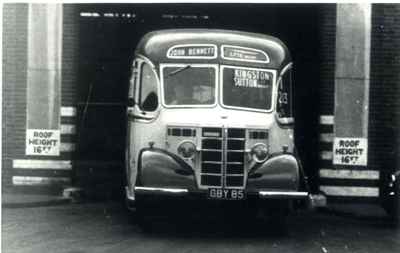 LT garage codes LT garage codes
In the RF Story is a list of the
Central Area garages that received allocations of RFs for
service. Thanks to Jim Andress in the RT/RF Register
newsletter and to David Ruddom, we are able to provide some
background to the development of the garage code system. Much
of Jim's information was in turn derived from 'The London B-Type
Omnibus' by Robbins & Atkinson.
A is for .. er,
Sutton. Sutton Garage opened in
1924, by which time A (Albany Street) had been closed for 8 years,
so its code was re-allocated. Seen here leaving Sutton Garage
in 1947 is Bedford OB GBY85, owned by John Bennett and
hired to LT for operation of the 213 during the
post-war shortage of buses. Photo © Alan Cross
The LGOC had three-letter codes on horse buses
and early motor buses, carried in the same familiar position as the
garage plates. The first letter indicated the area of stables
the bus was working from and the other two the route
and 'time' (now called duty), see next
page.
It was in November 1911 that the system of garage codes and
running numbers that (broadly) still
persists was introduced. The first group of garage codes to
be allocated were single letters, usually (but not always) derived
from the name. Thus A was initially used for Albany
Street. Slightly reminiscent of motor index marks, I, O
and Z were not used (although Q was).
From 1912, as more garages opened and the existing code
sequence was exhausted, two-letter codes were introduced, initially
running from AB to AV. In some cases (such as A), codes from
closed garages were reused. After 1913, codes were allocated
that again were derived from the name of the garage (e.g. CF Chalk
Farm in 1916). When Tilling merged with LGOC, their garages
received special codes - TB Tilling Bromley, TC Tilling Croydon and
TL Tilling Lewisham (Catford).
Trams and trolleybuses did not display depot codes, at least
until the trolleybuses were taken under the wing of Central
Buses in 1950 when the depots were allocated codes. Because
some names were duplicated, some trolleybus depots (for example
Holloway, renamed Highgate HT) and some bus garages (for example
Hanwell HW, renamed Southall) were renamed, although bus
garage codes remained unchanged.
For many years, the garage code was carried on an aluminium
stencil plate slotted onto each the side of the bus. In 1959,
certain Central Area garages painted the codes in the space between
the slots, and this practice became the norm in 1960. Garage
code stencils were however still used for loans between garages and
other temporary allocations.
A few of the original single-letter codes are still carried by
the same garages 100 years on, such as T (Leyton), although most of
the buildings have been rebuilt. A great many, however,
including quite a few of the RF garages, have now succumbed to
other uses or to housing development. For a listing of the
codes used over the years up until privatisation, see
John Hinson's site.
Nowadays, a garage code is not always displayed,
but TfL still have official codes for all garages used by
current operators. For full details, see the London Bus
Routes site.
For a discussion of running numbers, which follow the garage
code on the side of a bus, see the next
page.
|